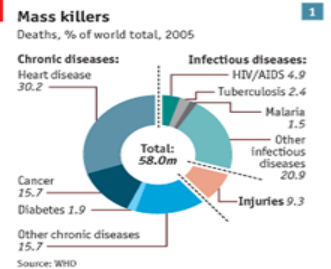Introduction
Public Health can be considered as something which plays a crucial role in the forward economy and health of the country (Modi, Palmer and Armstrong, 2014). In the present report, the role of different Agencies has been 3 dimensions which help in reducing different diseases from the overall Nation. Apart from this, a report will further argue as to how the lifestyle of people will be changed or made better with improved quality of social health care.
TASK 1
1.1 Role of different agencies in identifying health levels and different diseases in communities
A lot of organisations deal with providing health and medicinal services to people residing in the UK as well as other parts of the world. In this report, three basic organisations are studied namely the World Health Organisation, the National Health Services and the General Medical Council. All these organisations aim towards providing healthcare facilities to people worldwide(Braveman and Gottlieb, 2014). Also aim of all these organisations is the same even if they follow differentiated objectives.
It has also been found out that the World Health Organisation does not deal with directly local people rather it aims to assist private organisations that work at providing healthcare facilities. They serve or deal with healthcare facility providers on the national level and not the individual level. They especially provide benefits to organisations that have just initiated their work or who are suffering losses. They are most active during natural calamities like earthquakes, floods etc. WHO is working at identifying conditions of health care services worldwide(Atrash and Carpentier, 2012).

Stuck with your Assignment?
Hire our PROFESSIONAL ASSIGNMENT WRITERS and Get 100% Original Document on any Topic to Secure A+ Grade
Get Assignment Help
Apart from this, there are some other business organisations that are also present in the United Kingdom that also help in analysing the level of healthcare facilities and also study about various diseases such as the General Medical Council. This agency mainly aims at protecting patients by delivering efficient training to employees as per needs and requirements. They also set timely standards for doctors as well as services provided by them are monitored so that the best quality of services are provided to patients. Another one of the biggest organisations which was found in the UK is National Health Services and it is the biggest single entity working in this area. (National Health Service, 2018). NHS is providing free-of-cost services to its customers and also collaborates with WHO in identifying levels of health and diseases.
1.2 Epidemiology of infectious and non-infectious disease
The study of disease transmission is the investigation of the incidence, circulation and occurrence of illnesses in the network. It manages every one of the components related to the circumstances and end results of the sickness. The examination should be possible on non-irresistible and also irresistible ailments. In the present setting, Diseases like foodborne disease (FBD), Microbes transmitted: salmonella, E. Coli and some more (Bowleg, 2012).
Vulnerable groups: People of all ages and both genders are defenceless against FBDs. In the UK, the groups that are most helpless against sustenance-borne ailments are kids. Powerlessness for nourishment-borne infections additionally relies upon the safe arrangement of a person. Individuals with harmed safe frameworks are more powerless against pathogen attacks.
Epidemiology of Obesity
Incidence Rates: The rate of increase in obese cases is at an alarming stage in the UK. In men, the percentage increased from 0.2% to 1.8% from 1993 to 2010. In women, the hike in percentage is more than is, from 1.4% to 3.6% in the same years as above.
Causes: many reasons can lead to an increase in weight or accumulation of fat in the body. Some of the causes are an imbalanced diet, Genetic defects, Damage to the hypothalamus, Intake of drugs, and Changes in lifestyle.
Obesity is considered as the main problem a situation where accumulation of fat takes place in the body to such an extent that it becomes the reason for many health problems. Study shows that 20% of the adult population was suffering from HIV in England by 2014 and they stay undiagnosed and this percentage is rising day by day (Betancourt and et. al., 2016).
1.3 Effectiveness of different approaches to control the incidence of disease in communities
It is been analysed that there is an ample number of approaches which are being made by the government, private hospitals and Healthcare providers to control the incidence of disease in communities (Kohl 3rd and et. al., 2012). It has been found that most of the approaches majorly help in the prior targeting of diseases that are on the verge of causing ill effects to society. Below are some of the approaches that aid the control of diseases in communities:
Screening: Screening is another strategy that can be used to control the diseases in the communities. Screening refers to prior medical testing for the disease without observing the symptoms of that disease. This prior testing helps in the identification of the occurrence of a disease in an individual so that he can be treated before the attainment of that disease. Screening can be done in two ways. Universal screening refers to screening of a particular group of the population. Another type of screening is case finding which refers to screening of the individuals who are assumed diseased (Brett and et. al., 2014).
Immunisation: This is considered a technique which mainly helps an individual or patient is the technique by which an individual can be made immune to certain infections. It can be done by vaccination. Vaccines for a particular disease make an individual resistant to that disease.
TASK 2
2.1 Research to determine current priorities and approaches to the provision of services for people with disease
It is being analysed that there are many chronic diseases like HIV in England (London) with almost half of the population suffering from this disease. Therefore, it is vital for the government and agency to protect the whole nation from this chronic disease with priority (Sallis and et. al., 2012). On the other hand, it is also required for the government to focus on developing a number of strategies so that diseases can be reduced to zero that are being considered as mass killers.

From the above given image, it is computed that HIV/Aids is the deadliest infectious disease which is majorly increasing on a regular basis. Some of the policies in the present context are given below:
- Primary Prevention: Primary prevention refers to the foremost preventive measures that have been used to prevent the population from the disease by educating them about HIV and other diseases (Popescu and Predescu, 2016).
- Secondary Prevention: If a woman is found infected with the HIV virus, it is required for her to be treated well so that other people do not get infected because of it. NHS mainly introduced a health care program of testing the blood of every pregnant woman.
- Tertiary Prevention: This is considered as the last step of prevention which directly aims at the patient who is already suffering from chronic diseases. In the UK, the NHS has made efforts towards palliative care in the case of HIV and cancer.
2.2 explain the relationship between the prevalence of disease and requirements of services to support individuals within the health and social care service provision
In the present context, it is being analysed that the relationship between the prevalence of disease and the requirements of service might easily help sufferers get cured of diseases which are being shared with them. On the other hand, the Prevalence of disease helps in gaining relevant data related to people who majorly faced illness from the total number of individuals who have been studied. With the help of this, a proper plan can be made related to service which needs to be given related to issues (Wood and et. al., 2014). Thus, this can be considered as a relation among the prevalence of disease and which can deliver the right information to practitioners to make vaccines for diseases like HIV and other chronic diseases.
2.3 Impact of current lifestyle choices on future needs for Health & Social Care Services
In the United Kingdom, it is being found that there are two main health problems that are found to be severe and chronic HIV and Obesity and these are being considered as major issues which was faced by most people and affect their lifestyle.
HIV: The main cause of this contagious disease is having multiple sex without protection (Condom). Data shows that every year around 4.9% rate increases. Here, using protection and disposing of it correctly might help the people of London to reduce this rate and can impact positively their lifestyle as well.
Obesity: The main cause of being obese is the eating habits of the people. Wrong eating habits lead to the accumulation of fat in the body resulting in obesity. Data identifies that premature adult death rates can be reduced to 8%, if people maintain their weight. The survey suggests that the percentage of obese people increased by 13% in men and 10% in women.
Need to Consult Directly With Our Experts?
Contact UsConclusion
From the above-mentioned report, it is concluded that the epidemiology of illness can help in gaining the right knowledge or data related to the disease. This can help in making the right changes as per the requirements in existing vaccines or it helps in developing new vaccines for the disease. Away with this, health care units also need to come up with preventive measures for such diseases so that a high number of patients can be cured with ease.
References
Books & Journals
- Atrash, K. and Carpentier, R., 2012. The evolving role of public health in the delivery of health care. Journal of Human Growth and Development. 22(3). pp.396-399.
- Betancourt, J. R. and et. al., 2016. Defining cultural competence: a practical framework for addressing racial/ethnic disparities in health and health care. Public health reports.
- Bowleg, L., 2012. The problem with the phrase women and minorities: intersectionality—an important theoretical framework for public health. American journal of public health. 102(7). pp.1267-1273.
- Braveman, P. and Gottlieb, L., 2014. The social determinants of health: it's time to consider the causes of the causes. Public health reports. 129(1_suppl2). pp.19-31.
- Brett, J. and et. al., 2014. Mapping the impact of patient and public involvement on health and social care research: a systematic review. Health Expectations. 17(5). pp.637-650.
- Garner, A. S. and et. al., 2012. Early childhood adversity, toxic stress, and the role of the paediatrician: translating developmental science into lifelong health. Pediatrics. 129(1). pp.e224-e231.
- Kohl 3rd, H. W. and et. al., 2012. The pandemic of physical inactivity: global action for public health. The Lancet. 380(9838). pp.294-305.
- Minkler, M. ed., 2012. Community organizing and community building for health and welfare. Rutgers University Press.
- Modi, M. N., Palmer, S. and Armstrong, A., 2014. The role of Violence Against Women Act in addressing intimate partner violence: a public health issue. Journal of Women's Health. 23(3). pp.253-259.
- Popescu, G. H. and Predescu, V., 2016. The role of leadership in public health. American Journal of Medical Research. 3(1). p.273.
- Sallis, J. F. and et. al., 2012. Physical education's role in public health: Steps forward and backwards over 20 years and HOPE for the future. Research Quarterly for Exercise and Sport. 83(2). pp.125-135.
- Wood, A. R. and et. al., 2014. Defining the role of common variation in the genomic and biological architecture of adult human height. Nature genetics. 46(11). p.1173.



 Company
Company


















